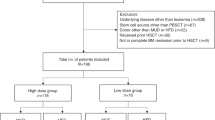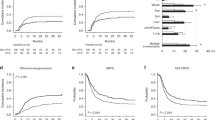Abstract
Immunosuppression has recently been proposed for low-risk myelodysplastic syndromes (MDS) to reverse bone marrow failure by inhibiting intramedullary secretion of proapoptotic cytokines. We treated 35 MDS patients (24 refractory anaemia (RA), 10 RA with excess blasts and one chronic myelomonocytic leukaemia) with either horse antithymocyte globulin 15 mg/kg/day or rabbit antithymocyte globulin 3.75 mg/kg/day, each for 5 days. Median age was 63 years (range: 41–75). After 1 to 34+ months of follow-up (mean: 15+), four patients experienced complete haematological responses (CR), six good responses (GR) and two minor responses. All CRs and GRs occurred in patients with RA, in whom both horse and rabbit ATG yielded five responses out of 12 (42%). Time to response varied between 1 and 10 (mean: 3) months. The median duration of response was 9+ (1–17+) months; five patients are in continuing response. In all, 23 patients suffered side effects >°II WHO (the degree of toxicity encountered according to the internationally accepted WHO toxicity grading); one patient died 2 weeks after rabbit ATG from rhinocerebral mucormycosis. Parameters that correlated with response were duration of disease and RA subgroup. In our experience, immune-modulating therapy with either horse or rabbit ATG is feasible in patients with RA and short duration of disease.
This is a preview of subscription content, access via your institution
Access options
Subscribe to this journal
Receive 12 print issues and online access
$259.00 per year
only $21.58 per issue
Buy this article
- Purchase on Springer Link
- Instant access to full article PDF
Prices may be subject to local taxes which are calculated during checkout




Similar content being viewed by others
References
Ganser A, Hoelzer D . Clinical course of myelodysplastic syndromes. Hematol Oncol Clin N Am 1992; 6: 607–618.
Ganser A, Ottmann O, Seipelt G, Lindemann A, Hess U, Geissler G et al. Effect of long-term treatment with recombinant human interleukin-3 in patients with myelodysplastic syndromes. Leukemia 1993; 7: 696–701.
Raza A, Mundle S, Shetty V, Alvi S, Chepra H, Span L et al. Novel insights into the biology of myelodysplastic syndromes: excessive apoptosis and the role of cytokines. Int J Hematol 1996; 63: 265–278.
Deeg HJ, Beckham C, Loken MR, Bryant E, Lesnikova M, Shulman HM et al. Negative regulators of hemopoiesis and stroma function in patients with myelodysplastic syndrome. Leukemia Lymphoma 2000; 37: 405–414.
Smith MA, Smith JG . The occurrence, subtype and significance of hematopoietic inhibitory T cells (HIT cells) in myelodysplasia: an in vitro study. Leukemia Res 1991; 5: 597–601.
Sugarawa T, Endo K, Shishido T, Sato A, Kameoka J, Fukuhara O et al. T-cell mediated inhibition of erythropoiesis in myelodysplastic syndromes. Am J Hematol 1992; 41: 304–305.
Marsh JCW, Hows JM, Bryett KA, Al-Hashimi S, Fairhead SM, Gordon-Smith EC . Survival after antilymphocyte globulin therapy for aplastic anemia depends on disease severity. Blood 1987; 70: 1046–1052.
Frickhofen N, Kaltwasser JP, Schrezenmeier H, Raghavachar A, Vogt HG, Herrmann F et al. Treatment of aplastic anemia with antilymphocyte globulin and methylprednisolone with or without cyclosporine. N Engl J Med 1991; 324: 1297–1304.
Raefsky EL, Gascon P, Gratwohl A, Speck B, Young NS . Biological and immunological characterization of ATG and ALG. Blood 1986; 68: 712–719.
Tichelli A, Gratwohl A, Wuersch A, Nissen C, Speck B . Antilymphocyte globulin for myelodysplastic syndrome? Br J Haematol 1988; 68: 139–140.
Sulecki M, Shadduck RK, Zeigler Z . Anti-thymocyte globulin for hypoplastic myelodysplastic syndrome. Blood 1988; 72: 229.
Miescher PA, Favre H, Beris P . Autoimmune myelodysplasias. Semin Hematol 1991; 28: 322–330.
Mineishi S, Filippa D, Childs B, Castro-Melaspina H . Hypoplastic myelodysplastic syndrome (MDS): clinical, hematologic, and pathologic observations in 36 cases. Blood 1994; 84: 1245.
Biesma DH, van den Tweel JG, Verdonck LF . Immunosuppressive therapy for hypoplastic myelodysplastic syndromes. Cancer 1997; 79: 1548–1551.
Molldrem JJ, Caples M, Mavroudis D, Plante M, Young NS, Barrett AJ . Antithymocyte globulin for patients with myelodysplastic syndrome. Br J Haematol 1997; 99: 699–705.
Molldrem JJ, Leifer E, Bahceci E, Saunthararajah Y, Rivera M, Dunbar C et al. Antithymocyte globulin for treatment of the bone marrow failure associated with myelodysplastic syndromes. Ann Intern Med 2002; 137: 156–163.
Jonásová A, Neuwirtová R, Cermák J, Vozobulová V, Mociková K, Sisková M et al. Cyclosporin A therapy in hypoplastic MDS patients and certain refractory anaemias without hypoplastic bone marrow. Br J Haematol 1998; 100: 304–309.
Bennett JM, Catovsky D, Daniel MT, Flandrin G, Galton DA, Gralnick HR et al. Proposals for the classification of the myelodysplastic syndromes. Br J Haematol 1982; 51: 189–199.
Hellström-Lindberg E, Negrin R, Stein R, Krantz S, Lindberg G, Vardiman J et al. Erythroid response to treatment with G-CSF plus erythropoietin for the anaemia of patients with myelodysplastic syndromes: proposal for a predictive model. Br J Haematol 1997; 99: 344–351.
Kaplan EL, Meier P . Nonparametric estimation from incomplete observations. J Am Stat Assoc 1958; 53: 457–481.
Saunthararajah Y, Nakamura R, Nam JM, Robyn J, Luberiza F, Maciejewski JP et al. HLA-DR15 (DR2) is overrepresented in myelodysplastic syndrome and aplasic anemia and predicts a response to immunosuppression in myelodysplastic syndrome. Blood 2002; 100: 1570–1574.
Harris NL, Jaffe ES, Diebold J, Flandrin G, Müller-Hermelink HK, Vardiman J et al. The World Health Organization classification of the hematologic malignancies. Report of the clinical advisory committee meeting, Airlie House, Virginia, November1997. J Clin Oncol 1999; 17: 3835–3849.
Greenberg P, Cox C, LeBeau MM, Fenaux P, Morel P, Sanz G et al. International prognostic scoring system for evaluating prognosis in myelodysplastic syndromes. Blood 1997; 89: 2079–2088.
Kochenderfer JN, Kobayashi S, Wieder ED, Su C, Molldrem JJ . Loss of T-lymphocyte clonal dominance in patients with myelodysplastic syndrome responsive to immunosuppression. Blood 2002; 100: 3639–3645.
Aivado M, Rong A, Stadler M, Germing U, Giagounidis A, Strupp C et al. Favourable response to antithymocyte or antilymphocyte globulin in low-risk MDS patients with a ‘non-clonal’ pattern of X-chromosome inactivation in bone marrow cells. Eur J Haematol 2002; 68: 210–216.
Killick S, Mufti G, Cavenagh JD, Mijovic A, Peacock JL, Gordon-Smith EC et al. A pilot study of antithymocyte globulin (ATG) in the treatment of ‘low-risk’ myelodysplasia. Br J Haematol 2003; 120: 679–684.
Asano Y, Maeda M, Uchida N, Yokoyama T, Osaki K, Shimoda K et al. Immunosuppressive therapy for patients with refractory anemia. Ann Hematol 2001; 80: 634–638.
Steensma DP, Dispenzieri A, Moore SB, Schroeder G, Tefferi A . Antithymocyte globulin has limited efficacy and substantial toxicity in unselected anemic patients with myelodysplastic syndromes. Blood 2003; 101: 2156–2158.
Cheson BD, Bennett JM, Kantarjian H, Pinto A, Schiffer CA, Nimer SD et al. Report of an international working group to standardize response criteria for myelodysplastic syndromes. Blood 2000; 96: 3671–3674.
Aul C, Giagounidis A, Germing U, Ganser A . Evaluating the prognosis of patients with myelodysplastic syndromes. Ann Hematol 2002; 81: 485–497.
Acknowledgements
We are grateful to Professor Hartmut Hecker, Department of Biometry, Hannover Medical School, for his invaluable help with the statistical analyses, to Dietmar Klose, Department of Hematology and Oncology, Hannover Medical School, for graphical assistance and to Michael Morgan, Department of Hematology and Oncology, Hannover Medical School, for critical reading of the manuscript. This work was supported in part by Imtix SangStat GmbH, Leimen, Germany, to AG.
Author information
Authors and Affiliations
Corresponding author
Rights and permissions
About this article
Cite this article
Stadler, M., Germing, U., Kliche, KO. et al. A prospective, randomised, phase II study of horse antithymocyte globulin vs rabbit antithymocyte globulin as immune-modulating therapy in patients with low-risk myelodysplastic syndromes. Leukemia 18, 460–465 (2004). https://doi.org/10.1038/sj.leu.2403239
Received:
Accepted:
Published:
Issue Date:
DOI: https://doi.org/10.1038/sj.leu.2403239
Keywords
This article is cited by
-
Immunosuppressive therapy with rabbit antithymocyte globulin therapy for acquired aplastic anemia: a multi-institutional retrospective study in Japanese adult patients
International Journal of Hematology (2019)
-
Anämien mit Panzytopenie
Monatsschrift Kinderheilkunde (2015)
-
The inflammatory microenvironment in MDS
Cellular and Molecular Life Sciences (2015)
-
Restoration of hematopoiesis in a case of myelodysplastic syndrome associated with systemic lupus erythematosus treated with rituximab
Annals of Hematology (2015)
-
Real life experience with alemtuzumab treatment of patients with lower-risk MDS and a hypocellular bone marrow
Annals of Hematology (2014)



